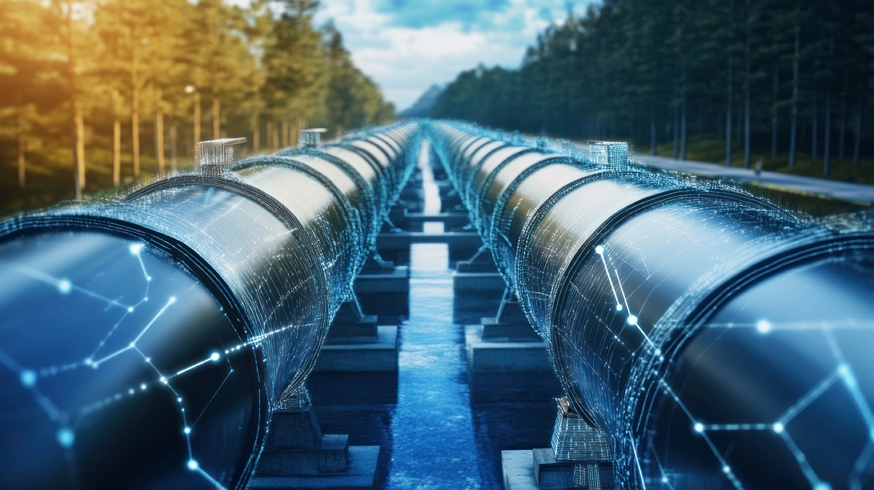#Introduction to Smart Pipelines
The energy sector is undergoing a digital transformation, and nowhere is this more evident than in midstream oil and gas operations; the critical link that connects upstream production with downstream processing and distribution.
Traditionally, pipelines have operated as linear systems, focused solely on transporting oil, gas and other fluids from one point to another. However, as the demands for safety, efficiency, and environmental accountability increase, so does the need for smarter infrastructure.
Enter the smart pipeline: a data-driven, sensor-enabled network that leverages the Internet of Things (IoT) and big data analytics to revolutionise how pipelines are monitored and managed.
Through the integration of real-time sensing technologies, cloud computing and predictive analytics, smart pipelines provide operators with enhanced visibility into their systems. These pipelines are capable of detecting anomalies such as leaks, pressure fluctuations and equipment failures before they become critical; ultimately minimizing downtime, reducing environmental impact and improving decision-making.
At the intersection of IoT and big data, midstream oil and gas operations gain a powerful toolkit to transition from reactive to proactive pipeline management.
Smart pipelines not only promise increased operational efficiency but also offer strategic insights into asset performance, helping companies stay competitive in a rapidly evolving energy landscape.
#IoT and Data Collection
At the heart of smart pipeline infrastructure lies a network of interconnected Internet of Things (IoT) devices designed to continuously monitor and report on the pipeline’s operational health.
These devices (ranging from sensors and meters to smart valves and actuators) are strategically installed along the length of the pipeline, often in remote or hard-to-reach areas.
Their primary function is to collect a wide array of real-time data points that are critical for ensuring pipeline integrity and operational efficiency.
Key parameters measured by these IoT devices include:
Pressure: Monitoring pressure at various points helps detect potential blockages, ruptures, or abnormal fluctuations that could indicate a leak or system failure.
Flow Rate: Sensors measure the volume and speed of materials moving through the pipeline, ensuring that flow remains within optimal ranges and alerting operators to inconsistencies.
Temperature: Changes in temperature can affect pipeline performance and safety. Continuous monitoring helps maintain stability and detect overheating or freezing conditions.
Corrosion Levels: Smart sensors, such as ultrasonic or electrochemical corrosion monitors, track the degradation of pipeline walls over time, enabling preventative maintenance before structural integrity is compromised.
These IoT devices are often connected via wireless communication technologies (such as LTE, satellite, LoRaWAN, or even private 5G networks), which allow them to transmit data in real time to central control systems or cloud-based platforms.
Once collected, the data is aggregated and stored in centralized databases, where it is accessible for advanced analytics, machine learning models, and visualization tools.
Operators can now identify and address issues early, optimize resource allocation and maintain regulatory compliance with greater accuracy and ease.
#Big Data Analytics
While IoT devices serve as the eyes and ears of smart pipelines, it is big data analytics that provides the intelligence. The massive volumes of real-time data collected from sensors must be processed and analysed efficiently to extract actionable insights. This is where big data analytics plays a critical role.
By using advanced analytical techniques, including machine learning, predictive modeling, and pattern recognition, big data platforms can sift through terabytes of incoming data to:
Detect Anomalies in Real Time: Analytics systems continuously monitor for deviations from normal operating patterns. For example, an unusual drop in pressure or a spike in temperature at a particular location may indicate a developing leak or equipment malfunction. Early detection enables faster response and mitigates potential damage or environmental harm.
Predict Failures Before They Occur: Historical data combined with real-time inputs allows predictive models to identify wear trends and forecast potential failures. For instance, if corrosion levels are increasing at a known rate, the system can predict when a segment of pipeline will require maintenance or replacement, allowing for proactive intervention rather than reactive repairs.
Optimise Operational Performance: Big data analytics helps midstream oil and gas operators optimise everything from flow balancing and pump scheduling to energy consumption. By analysing patterns over time, companies can identify inefficiencies and fine-tune operations for better throughput, reduced costs and enhanced safety.
Modern analytics platforms often incorporate visualization dashboards and AI-driven recommendations, providing decision-makers with intuitive, real-time visibility into pipeline operations.
As pipeline data volume and complexity grow, scalable, high-performance analytics become even more essential.
Together with IoT, big data analytics empowers midstream oil and gas companies to move from traditional pipeline monitoring to intelligent, data-informed pipeline management.
#Benefits for Midstream Operators
The integration of IoT and big data analytics into pipeline infrastructure brings a wide array of tangible benefits to midstream oil and gas operators. As pipelines evolve into intelligent, self-monitoring systems, companies gain more than just real-time visibility; they unlock new levels of operational excellence, safety, and cost-effectiveness.
Improved Safety
Smart pipelines significantly enhance safety across the entire network. Continuous monitoring allows for early detection of abnormal conditions before they escalate into hazardous incidents.
By identifying potential threats in real time, operators can take immediate corrective action, reducing the risk of accidents, environmental contamination, and personnel exposure to dangerous conditions.
Better Leak Detection
Traditional leak detection methods can be slow or imprecise, often relying on manual inspections or indirect indicators. In contrast, smart pipelines use a network of IoT sensors and machine learning algorithms to detect even small leaks early and accurately.
This capability minimises product loss, prevents environmental damage and ensures quicker response times, all of which contribute to regulatory compliance and public trust.
Enhanced Operational Efficiency
Big data analytics enables midstream oil and gas operators to optimize pipeline performance by identifying inefficiencies and balancing load distribution.
Real-time flow and pressure data allow for dynamic adjustments to pumping schedules, improving throughput while reducing energy consumption. Operators can also automate routine tasks and use data-driven insights to streamline decision-making processes.
Reduced Maintenance Costs
Predictive maintenance is one of the most powerful advantages of smart pipelines. Instead of relying on fixed schedules or reacting to breakdowns, operators can use data to anticipate when and where maintenance is needed.
This targeted approach helps avoid unnecessary service interruptions, extends equipment life and reduces the costs associated with emergency repairs and downtime.
#The Future of Smart Pipelines
As technology continues to advance, the evolution of smart pipelines is far from over. The convergence of artificial intelligence (AI), machine learning (ML), and real-time monitoring systems promises to drive even greater transformation in midstream oil and gas operations.
These innovations are setting the stage for a future where pipelines are not just smart, but fully autonomous, adaptive and self-optimizing.
AI-Driven Decision Making
Future smart pipeline systems will increasingly rely on AI to move beyond monitoring into automated decision-making. AI algorithms will not only detect anomalies but also recommend or initiate responses, such as adjusting flow rates, isolating problem segments or dispatching maintenance crews; without requiring human intervention. This level of automation enhances response times and reduces human error.
Advanced Machine Learning Models
Machine learning will continue to improve in its ability to predict complex failure modes, learning from historical data and evolving to handle new threats. These models will become more accurate and adaptive over time, enabling truly predictive maintenance strategies that further reduce downtime and extend asset life. ML can also analyse multivariate datasets, identifying correlations that humans might miss, leading to deeper operational insights.
Real-Time, Edge-Based Analytics
With the rise of edge computing, future smart pipeline systems will shift more processing power to the field, enabling real-time data analysis directly at the sensor or device level. This decentralisation minimises latency and allows for faster local responses to changing conditions, especially critical in remote or high-risk environments.
#Conclusion
Smart pipelines represent a fundamental shift in how midstream oil and gas assets are managed, blending IoT, big data and advanced analytics into an intelligent ecosystem.
As AI and real-time technologies mature, the industry is moving toward a future where pipelines are not just monitored; they’re self-aware, predictive, and optimised for both performance and sustainability.
For midstream oil and gas operators looking to stay competitive, embracing smart pipeline technologies is no longer optional; it’s essential.




